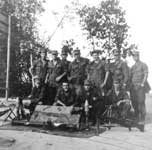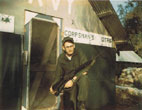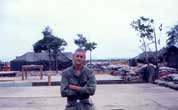
TET 1968, M Co. 3/5
This is NOT an official USMC combat operations page, but our personal attempt to recover as much information as we can about the ambush M Co. 3/5 ran into on Feb. 7, 1968, later known as part of the 1968 TET Offensive. Introduction is an excerpt from "The Tet Offensive and its Aftermath", 1968: The Definitive Year, by Edwin E. Moïs; and by Schulimson, Jack, LtCol. Leonard Blasiol, Charles R. Smith, and Capt. David A. Dawson, "U.S. Marines in Vietnam: 1968, the Defining Year".
Pictures, citations and remembrances were sent in by Marines and family members who fought in this battle or lost loved ones. This effort is dedicated to the survivors, and to their friends who made the ultimate sacrifice.
By late 1967, the US command in Vietnam was issuing very optimistic statements about weakening thinking. In its eagerness to make the situation look hopeful, the US command was underestimating the actual size of the Communist forces. In past years, a tradition had grown up of declaring a truce for a few days during Tet, the Vietnamese New Year, to allow people on both sides to celebrate this very important holiday with their families. During Tet of 1968, which came at the end of January, the Communists announced a truce but then launched a stunning offensive, attacking almost every major city in South Vietnam. One Communist unit got inside the walls of the US Embassy in Saigon and remained for several hours before being killed. US forces had made some preparations for the possibility of an attack, but not enough. Most ARVN units were caught totally by surprise.
*********************
1968: The
Definitive Year
Schulimson,
Jack, LtCol. Leonard Blasiol, Charles R. Smith, and Capt. David A. Dawson.
U.S. Marines in Vietnam: 1968, the Defining Year. Washington, D.C.:
History and Museums Division, United States Marine Corps, 1997, Page
160
Igor Bobrowsky with CAP D-2 remembered that Company M (3/5) was "ambushed in the streets near the north end of Thanh Quit ... A good number of M Company that survived the ambush got down to us, along with some of their dead and a lot of wounded." The heaviest action occurred in the 3d Battalion, 5th Marines and 4th Battalion, 51st ARVN sectors along Route l. Corporal Igor Bobrowsky with CAP D-2 located near the Thanh Quit Bridge along Route 1 remembered being besieged in his compound by North Vietnamese regulars. As he recalled suddenly the enemy was there and forced his Marines and PFs to take refuge in the compound together with many local villagers: "We were running out of ammunition and everything else, so that was a big fear."
According to Bobrowsky, the NVA suddenly disappeared as quickly as they had appeared. He later conjectured that "what saved us from being . . . taken out totally was the fact that they had bigger fish to fry, they were headed to Da Nang. The bigger fish was the 4th Battalion, 51st ARVN Battalion base camp about 5,000 meters north on Route l above the Thanh Quit River. At about 0300, two North Vietnamese battalions struck the ARVN compound. Two LVTH-6s from the Marine 1st Armored Amphibian Company attached to the llth Marines responded to a call from the U.S. Army advisor attached to the ARVN unit. Firing 290 105mm shells, the tractor artillery reportedly killed about 80 of the enemy attackers caught in the open.
About 0900, Lieutenant Colonel William K. Rockey, the 3d Battalion, 5th Marines commander, ordered a small command group and two companies, Company M of his battalion and Company F, 2d Battalion, 3d Marines attached to his command, to the relief of the ARVN camp. Accompanied by tanks and LVTs, Company F maneuvered to the north of the ARVN base. Company M advanced toward a hamlet to the south of the ARVN. Both Marine companies encountered heavy small-arms fire and rocket-propelled grenades as they approached their objectives. The Marine companies then pulled back and called in artillery and air.
Lieutenant Colonel Rockey then directed Company G of the 3d Marines, also attached to him, to move up along the banks of the Bau Xau River toward a blocking position southwest of the ARVN base "to seal up" any escape route in that direction. As Company G began its redeployment along the river route it ran into enemy forces attempting to retreat in that direction. Rockey then ordered a platoon from his Company K to reinforce Company G. By the end of the day, the elements of the four Marine companies had established their night positions. During the day's fighting, Rockey's battalion killed 107 of the enemy and took two prisoners. His Marines sustained casualties of 11 killed and 53 wounded.
The fighting continued during the night and into the next day. From their night positions, Company G observers saw large numbers of North Vietnamese approaching them from the north. The Marine company called in mortar and artillery fire. Battery F, 2d Battalion, 11th Marines alone shot off some 1,200 rounds. Even in the face of the artillery, the North Vietnamese continued their advance upon the Marine positions. Company G repulsed a number of probes throughout the night until the enemy broke contact at dawn.
The 3d Battalion, 5th Marines together with Companies F and G, 2d Battalion, 3d Marines then began methodically to eliminate pockets of enemy resistance in the general area. In one contact about 1645, Company M, 3d Battalion, 5th Marines met a force of 100 enemy troops. The Marines and VC in the ensuing firefight fought at a range as close as five meters from one another with the Marines achieving the upper hand. According to the Marine after-action report, Lieutenant Colonel Rockey's battalion and the attached two companies from the 2d Battalion, 3d Marines accounted for more than 320 enemy dead in less than 36 hours.
By this time, Major General Robertson, the 1st Marine Division commander, was worried about the ability to contain the enemy offensive south of Da Nang. The VC R-20 and V-25th Battalions had struck again at Hoi An, engaging both the Korean Marine Brigade and the 1st and 2d Battalions of the ARVN 51st Regiment. North Vietnamese battalions from the 2d NVA Division had eluded the Korean and ARVN defenses in the southern sector and had penetrated the defensive perimeter of the 2d Battalion, 3d Marines and 3d Battalion, 5th Marines just below the main base. While the Marine battalions successfully kept these initial assaults on the night of 5-6 February in check, General Robertson was not sure how much longer they could. The fighting during the preceding week had drawn down the strength of the ARVN and the two Marine battalions and the enemy division still had uncommitted units that it could throw into the tray. General Robertson shared these concerns with General Cushman, the III MAF commander.
On 7 February, this request led to a strange confrontation, if there was a confrontation, between General Westmoreland and General Cushman. On the previous night as well as attacking at Da Nang, North Vietnamese troops overran the Special Forces Camp at Lang Vei, south ot Khe Sanh. Believing that III MAF should have relieved the camp and fearing that the enemy was about to launch the much-heralded attack on Khe Sanh itself, the MACV commander called for a special meeting on the morning of 7 February of the senior U.S. commanders in I Corps. At the meeting itself, he became even more upset as he learned about the situation at Da Nang. As he later confided, 'the VC were getting closer and closer to Da Nang Airbase. There was an absence of initiative by the CG III MAF, in dealing forcefully with the situation. According to General Westmoreland's account, he acted rather abruptly and made his displeasure known. Shocked at what he considered things left undone, he ordered 'in exasperation' Major General Robertson of the 1st Marine Division and Major General Samuel Koster ot the Americal Division from the room. The MACV commander told the two generals 'to return only when they had worked out a viable plan tor closely c(x)rdinated offensive action against the enemy threatening the airfield. Apparently, however, although conscious of Westmoreland's sense of urgency about the tactical situation at Da Nang, the Marine commanders were unaware of Westmoreland's unhappiness about the arrangements. According to both Generals Cushman and Robertson the meeting was not acrimonious. General Robertson remembered that he briefed the MACV commander on the enemy and stated that he needed more troops. Westmoreland then turned to Major General Koster and merely said: ''Sam, you let Robby have two, three, or even four battalions if he needs them.''
The MACV commander then dismissed Koster and Robertson from the meeting 'to go out and work out the details.' General Cushman later commented that he did not normally order the movement of Army units until he and General Westmoreland 'got together and agreed upon a plan." His view was that the purpose of the meeting was to obtain Westmoreland's approval for the reinforcement of Da Nang by the Americal Division. Despite the mixed perceptions about the meeting, the various parties quickly worked out a plan of action. Colonel Smith of the III MAF staff, who sat in on the conference between Generals Koster and Robertson, remembered that after studying the situation map, the conferees "came to the conclusion that the best way of stopping this attack was to interpose an equally strong force between the 2d NVA Division and the Da Nang Vital Area." The idea was to stop the enemy division from entering the Vital Area rather "than pushing him from the south and in effect pushing him" into the sector. The planners decided to send a two-battalion Army task force from the Americal Division into the northern sector of the 3d Battalion, 5th Marines near Route l south of the Cau Do.
The afternoon of 7 February, General Cushman issued the orders for the movement of the Army units to Da Nang. Major General Koster was to deploy one battalion immediately and to send the task force command group and remaining battalion the following day. Upon arrival at Da Nang, the Army units were to be under the operational control of the 1st Marine Division. The mission of the Americal task force was to "block enemy movement to the north, deny enemy access to the Da Nang Vital Area, and destroy enemy forces.
According to plan, late in the afternoon of 7 February, Marine helicopters brought the lead Army battalion, the 1st Battalion, 6th Infantry, 196th Light Infantry Brigade, commanded by Army Lieutenant Colonel William J. Baxley, into a landing zone near the hamlet of Duong Son (l) just off the old railroad tracks, about 2,000 meters south of the Cau Do. The Army troops quickly moved into night positions and encountered only harassing sniper fire or an occasional mortar round.
The night of 7-8 was relatively uneventful throughout the Da Nang TAOR until about 0345. At that time, enemy mortar rounds fell into the CAP 'E-A compound in Lo Giang (l) hamlet, about 2,000 meters northeast of Duong Son (l). While beginning with the mortar bombardment, the enemy soon escalated the fighting. By daylight, enemy ground forces surrounded the CAP hamlet. At that point, to ease the pressure on the CAPs, General Robertson about 0700 deployed the Army battalion to Lo Giang (5), about 1,000 meters north of Lo Giang (l), just below the Cau Do. The Army troops soon found themselves engaged with another enemy battalion. The 1st Marine Division commander then reinforced the Army unit with two Marine companies, Company G, 2d Battalion, 3d Marines and Company I, 3d Battalion, 5th Marines. This fighting continued to rage until late afternoon.
In the meantime, CAP E-4 continued to hold out against overwhelming odds. A small Combined Action headquarters detachment of 15 men from Hoa Vang also attempted to reinforce the embattled CAP, but never reached Lo Giang (l). Only l of the original 15 men survived. By mid-afternoon CAP E-4 was nearly out of ammunition. At 1550, under cover of helicopter gunships and fixed-wing aircraft, Marine helicopters successfully evacuated the Combined Action platoon out of Lo Giang (l). In Lo Giang (5), the action lasted for another hour and a half, when the NVA/VC forces tried to break contact. In that fighting, the soldiers and Marines killed over 150 of the enemy. By that evening, Army Task Force Miracle, under Army Colonel Louis Gelling, the commander of the 196th Light Infantry Brigade, had been established in the Da Nang area of operations. Gelling, the task force headquarters, and the 2d Battalion, 1st Infantry, under the command of U.S. Army Lieutenant Colonel Lyman H. Hammond,Jr., had arrived from Chu Lai that afternoon.
Establishing his command post near Duong Son, Colonel Gelling assumed operational control of the 1st of the 6th near Lo Giang (5) and placed the 2d of the 1st in blocking positions below Lo Giang (l). During the following day, while the 1st of the 6th mopped up in its area, the 2d Battalion, 1st Infantry attacked north. The latter battalion ran into a North Vietnamese battalion and engaged it in a nine-hour battle. Pulling back its assault elements, the Army unit saturated the area with artillery. They later found 46 enemy bodies and took a wounded man prisoner.
Intelligence indicated that the enemy unit in the southern hamlet was from the 3d Battalion, 31st NVA Regiment, and the units in Lo Giang (5) were from the 1st VC Regiment. In the meantime, that day, on the eastern flank of the Army units, on the east bank of the Vinh Dinh River, the 2d Battalion, 3d Marines encountered two companies from the 1st VC Regiment and killed about 90 of the enemy. The enemy offensive in the Da Nang sector had spent itself. During the next few days, Task Force Miracle conducted sweeps in its sector and encountered relatively little resistance. Both the 2d Battalion, 3d Marines to the east of the Army task force, and the 3d Battalion, 5th Marines to the south, also reported relatively little enemy activity in their sectors. Only the 7th Marines to the west experienced an increase in incidents as North Vietnamese regulars and the VC main force troops moved through the western TAOR to return to their mountain strongholds in Base Area 114 and through Charlie Ridge into "Happy Valley.
To the south, in the Korean sector, the ROK Marines with the assistance of the ARVN again drove Communist forces out of the Hoi An environs. According to an enemy NCO from the 31st NVA Regiment captured in the fighting, the mission of his unit was to "attack Hoi An, five times if necessary, and set up a liberation government." Hoi An still remained in friendly hands.
In the Que Son Valley on 9 February, the Americal Division engaged elements of the 21 st NVA Regiment, the only regiment of the 2d NVA Division that had not been in the Da Nang sector. The 21st was also in retreat. According to Marine intelligence reports, on 9 February, the 2d NVA Division moved its headquarters back to the Go Noi from its more forward positions. The following day, the same sources indicated that both the lst VC and the 3d NVA Regiments had also withdrawn to the Go Noi.
On 11 February, General Cushman observed the 2d NVA Division "appeared to be withdrawing from contact southward" and ordered his subordinate commanders to continue to press the attack. He, nevertheless, released TF Miracle from the operational control of the 1st Marine Division and returned it to its parent command. The task force headquarters and its two battalions returned to Chu Lai the following day. The battle for Da Nang was largely over. Despite limited attacks later in the month, these were largely, as a report stated, "an attempt to maintain the facade of an offensive.
During the Da Nang Tet offensive, both sides experienced heavy casualties, but the Communist forces proved to be no match for the allied forces. According to III MAF figures, from 29 January through 14 February at Da Nang, Marines sustained 124 killed and more than 480 wounded. Army forces in the Da Nang area including the troops from Task Force Miracle suffered 18 dead and 59 wounded. South Vietnamese and Korean casualties probably equalled or slightly exceeded the American. U.S. estimates of enemy casualties ranged between 1,200 and 1,400 dead. Colonel Smith believed that the 7 st VC Regiment alone lost about 600 men. The 2d NVA Division still remained intact, but obviously was not about to renew the offensive. From almost every account, the Communist attack in the Da Nang TAOR was very inept. Despite the thinness of the Marine lines and the ability of both the NVA and VC to infiltrate, the enemy never capitalized on these advantages. According to a VC after-action report early in the offensive, the writer complained that the "commander did not know . . . [the] situation accurately . . . and that orders were not strictly obeyed."
In a 1st Marine Division analyses, the author commented that the 2d NVA Division's approach was "along a single axis of advance so that his eventual target was easily identifiable." Moreover, once the NVA units arrived south of Da Nang they "made no further attempts at maneuver even while being hunted by Marine and Army units, and when engaged, seldom maneuvered, except to withdraw." General Robertson, the 1st Division commander, observed that the delay of the 2d NVA Division into the picture may have been because the Communist forces "got their signals mixed ...." The VC were supposed to be inside "when the NVA division came marching down main street. You get your timing off and you've got problems." Another possible explanation was that the Da Nang attack may have been a secondary assault-to cause as much damage as possible and divert allied forces from the almost successful effort of the Communist forces to capture the city of Hue.
(*Igor Bobrowsky with CAP D-2 remembered the "retreating NVA/VC were certainly more pathetic on the way back out to their lairs than they were coming in on us. At the same time though, they were . . . somehow scarier-because they were so clearly desperate in trying to get away, like small packs of cornered rats looking for holes to scurry through in a burning building." Bobrowsky Comments).
(** Brigadier General Paul G. Graham who was the 1st Marine Division Operations Officer (G-3) at the time disagreed with the last statement, writing "Hue had no military value to the NVA/VC. Da Nang was the prize-for success in that endeavor could have had a serious effect on the Allied efforts in the III MAF area." BGen Paul G. Graham, Comments on draft, dtd 20Nov94 (Vietnam Comment File)).
************************************************************
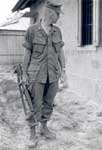
(click to enlarge)
(picture courtesy of Bill Rockey)

Navy Meritorious Unit Citation 3rd Battalion, 5th Marines
30 January-15 February 1968
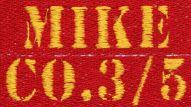
Submitted by Curtis Batten, 1st plt. M Co. 3/5
They came running through the area hollering "SADDLE UP". Gunny (black, real nice, he is the one that named me SKINNY, Harris was his last name I think) was hollering fighting gear only!! Got the dog crap kicked out of us that night also. We walked (or ran is a better word) straight into one hell of an ambush, man were they waiting for us. They knew we would come to the aid of that damn ARVN outfit. I wish I could remember the name of that Lt. he was a small man, troops loved him, always carried a grease gun. He is the one that took three of us and encircled the ambush and broke their back. That allowed the rest of the company to get across a small bridge and then into the ARVN compound. He never hesitated in what we did. I had no idea what he was up to, I just happened to be behind him in the column when we were hit, he grabbed me and two others, and off we went.
We
ran to the left following along side of the buildings in the little
village. That village actually had hard side (masonry) buildings.
The ARVN compound had a 106 just to the right of the gate as we
went in. After we got into the compound we had to listen to the
gooks blow bugles and holler at us from the other side of the rice
paddy, over a PA system, they would play Hanoi Hanna for awhile,
she told us how we were defeated, that the entire South Vietnamese
population was rising up to fight us. Our Skipper (I think it was
Mitchell then), anyway the Skipper, whoever it was made them lower
the 106, load that sucker with a beehive round and then SILENCE
that bull horn. It worked, never heard another peep out of them.
That Lt., that ambush, that night was the dream that I had nightmares
about for many, many years. Semper Fi~Curt

(click to enlarge)
(picture
courtesy of Curtis Batten)
***************************
Front: Forrest Bartram, Tom Briggs (KIA FEb. 8), Frank Ambrose (WIA Feb. 7), Bob Montgomery (WIA Feb. 7)
Back: Steve Howsmon, Richard Hipp, Unidenified, Brad Reynolds (WIA Feb. 7), Tom Hoying, Richard Markel, Unidentified(If anyone recognizes the unidentified Marines, please let us know)
***************************
(click to enlarge)
"Doc" Phil Stern, M Co. 3/5 Corpsman
WIA Feb. 6, 1968
(picture and citation courtesy of Phil Stern)
The President of the United States takes pleasure in presenting the SILVER STAR MEDAL to
HOSPITALMAN PHILIP L. STERN
UNITED STATES NAVYFor service as set forth in the following
CITATION:
For conspicuous gallantry and intrepidity in action while serving as a Corpsman with Company M, Third Battalion, Fifth marines, First Marine Division in connection with operations against the enemy in the Republic of Vietnam. On the morning of 6 February 1968, Company M was maneuvering toward suspected enemy positions in the village of Thanh Quit when the Marines suddenly came under intense hostile small arms, automatic weapons and mortar fire and sustained several casualties.
Disregarding his own safety, Hospitalman STERN fearlessly moved across the fire-swept terrain and began rendering first aid to the wounded men. While treating a casualty, he was wounded in the ankle and became unable to walk. Steadfastly refusing medical treatment, he ignored his injury and crawled about the hazardous area, administering first aid to his comrades.
When his unit was ordered to withdraw to a more defensible position, he assisted in evacuating the casualties and, utilizing a poncho, dragged a wounded man across the fire swept terrain to a position of relative safety. Only after all casualties had been moved to covered positions, did he permit himself to be evacuated.
By his courage, sincere devotion to duty in the face of great personal danger, Hospitalman STERN upheld the highest traditions of the Marine Corps and the United States Naval Service.”
FOR THE PRESIDENT,
V. H. KRULAK
LIEUTENANT GENERAL, U. S. MARINE CORPS
COMMANDING GENERAL, FLEET MARINE FORCE, PACIFIC*******************************************
(click to enlarge)
Joe Bowers, 1st platoon, M Co. 3rd Bn. 5th Marines
WIA Feb. 8 and 15, 1968
(picture courtesy of Joe Bowers)*********************
(click to enlarge) 1st platoon, M Co. 3rd Bn. 5th Marines
Terry Otell
(picture courtesy of Terry Otell)

(click to enlarge)
Terry Otell
received the
Navy Achievment Medal for 7 February 68
(citation
courtesy of Terry Otell)
***********************
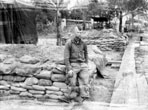
(click to enlarge)
Bob Montgomery
1st platoon, M Co. 3rd Bn. 5th Marines
(picture
courtesy of Bob Montgomery)
"Was
severely wounded 7 Feb. 68 just after the TET Offensive when we
walked into a village, and into a company-sized NVA ambush. A lot
of dead Marines were taken out that day.
Feb.
7, 1968
Submitted by Frank Ambrose, M/3/5
On Feb. 5th or 6th 1968, we (Mike Company, 3rd Battalion, 5th Marines, 1st Marine Division) had made contact with some NVA from the 2nd NVA regiment. We were able to take some prisoners (I think 11). The U.S. Army had more gear then we did. They had a 106 recoilless mounted on a jeep (called a Mule). As we were always in combat, prisoners were no big thing. From what I understand we wound up swapping the Army unit our prisoners for the Mule. That way they would get credit for the NVA POW's. We got the much needed Mule.
On Feb. 7th, there
were 15 or 16 of us escorting the Mule back to the perimeter. We were
on Hwy. Route 1, south of Danang. There was an M79'er and two other
Marines in front of me. We were walking about 10 yards apart. I was
the only machine gunner. There were only two ammo humpers that day
as we were short on men due to the Tet Offensive which had started
a week or so earlier. Usually there would have been 3 ammo humpers
carrying extra M60 ammo.
We crossed a small bridge (about 60 to 70 ft. long). We were just
entering a village going toward the old French fort. The point man
was about 60 yards past the bridge. I with the M60 was in front of
the Mule, about 40 yards back from the point man. I think the M79'er
was second from the front. The Mule had just cleared the bridge when
all of a sudden civilians on the road start running. Some one hollered,
"ambush!" Then almost instantly a rocket or mortar hit the
front of the Mule killing both guys on it. The 106 was pointing to
the back left over the bridge where we had come from.
All hell broke loose. I saw one NVA throw a grenade at me. I was able
to shoot him before the grenade went off. I took a lot of shrapnel
in the face and chest. I guess it was his responsibility to take out
the machine gunner. We jumped in the drainage ditch along side the
road. It was about 4 ft. deep. They were shooting so much at us, I
will never forget trying to look up for targets. The sand blasting
off my face like a sand blaster from their rounds hitting the ground
in front of me. The guys that were still alive were running out of
ammo, as it turned out to be a full 3 company NVA ambush. Approximately
200 NVA against the few of us who had not been killed from the get
go. The
M79'er had been wounded, and shortly ran out of M79's. There were
guys dead on both sides of me. The one on my left was blown in half
from a rocket or mortar. The M79'er came back through the ditch and
jumped over me as I was shooting. Everyone else up front had been
killed. He was taking the ammo off the dead Marines and giving it
to me. (I guess about 30 minutes had lapsed since we had walked into
the ambush.) I had seen 3 Marines run out to the 106 to try to turn
and fire it. At the time I did not understand why as it was pointed
back left of us. We were being hit from the village buildings in front
of us. The Mule's left side tires were blown, and it was leaning to
the left.
I later found out that there were 2 companies of NVA coming up behind
us through a rice paddy. One company was in front of us. Two of the
Marines had been shot and killed going for the 106, and the third
was laying on Hwy. 1 screaming from bullet wounds. I think that he
later died. They had been trying to get to the 106 to fire it at the
advancing NVA behind us. It had a beehive round in the chamber. That
definitely would have put a hurting on the NVA had it been fired.
There were just a few of us left. The M79'er had been wounded in several
parts of his body and went unconscious. That left me alone with the
next live man about 20-30 yards behind me, back by the bridge. I could
not see the NVA behind us and was unaware of them being there. Luckily
for me the sergeant who was closer to the bridge saw 2 of them about
10 yards behind me trying to come over the other side of the ditch
and shot them both. I was firing at the main ambush in front of us
trying to preserve ammo. Like
I said, it had been about 30 minutes before more Marines from our
company started to get to us. Jeff Goss was a grunt with them. He
ran across the bridge (under very heavy fire) and jumped in by the
Marines. Then he saw me up front alone still shooting. He jumped up
on the road and ran up to my location (again, under very heavy fire).
I was bleeding bad, and my whole face was blood. As I remember, he
laid out some cover fire while I crawled over the dead Marine to my
right. We noticed the M79 man appeared to still be alive, so Jeff
took my M60 as it was 22 lbs. and gave me his lighter M16. He took
the Marine's right shoulder, and I took his left, and we drug him
face down through the ditch to the safety of a cement building. Part
of the old French fort. He lived, and we now talk regularly. At the
time I had figured he had died, and only learned different a few years
ago. As
more Marines advanced across the bridge, the NVA broke and ran. I
was told the support Marines chased them for 2 days before they caught
them and virtually wiped them all out.
L/Cpl. Jeffery Alan Goss USMC who was awarded the SILVER STAR for his actions that day, February 7th, 1968, was among the first to arrive as support for us. He ran across a bridge with no cover under very heavy enemy fire. Then he ran about forty yards up Hwy. 1 to get to my location. Again, under very heavy enemy fire. L/Cpl. Goss saved two of us that day, and no telling how many others. There is no doubt in my mind that had it not been for his brave actions and willing to self sacrifice, two more of us would have perished that day next to Hwy 1. L/Cpl. Jeffrey Goss perished from enemy small arms fire on May 24th, 1968 during Operation Allen Brook. He is on the Vietnam Wall-Panel 69E- Line 4.~Frank Ambrose, M/3/5
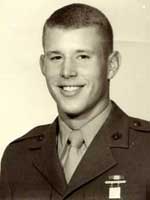
(click to enlarge)
Jeffrey
Alan Goss, M Co. 3/5
(Jeffrey Goss received
the Silver Star for 7 Feb. 1968, he was Killed In Action on 24
May 1968 during Operation ALLEN BROOK.
(see also Jeffrey
Goss Memorial page)
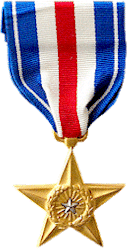
The President of the United States takes pride in presenting the SILVER STAR MEDAL to
LANCE
CORPORAL JEFFREY A. GOSS
UNITED STATES MARINE CORPS
for service as set forth in the following
CITATION:
For conspicuous gallantry and intrepidity in action while serving with Company M, Third Battalion, Fifth Marines, First Marine Division (Reinforced), in the Republic of Vietnam on 7 February 1968. Lance Corporal (then Private First Class) Goss was a member of a reaction force assigned to assist a friendly patrol that had established contact with a numerically superior enemy force on National Route One south of Danang.
As the force arrived at the besieged unit's position, they were taken under devastating enemy small-arms, automatic weapons and mortar fire. Observing a wounded machine gunner lying in an area dangerously exposed to enemy fire, Lance Corporal Goss fearlessly ran across the fire swept terrain to the side of the casualty.
After picking up the wounded man and machine gun, he began maneuvering toward a Combined Action Platoon's perimeter 400 meters away. As he was brought under intense enemy fire, he placed the injured man in a covered position and began delivering a heavy volume of accurate suppressive fire on the enemy position. Undaunted by the enemy rounds impacting around him, he continued to expose himself to provide covering fire while all the casualties were evacuated.For the President,
Commandant of the Marine Corps**********************
BUCKLES, WILLIAM T.
Silver Star Citation:
The President of the United States takes pride in presenting the Silver Star Medal (Posthumously) to William T. Buckles, Lance Corporal, U.S. Marine Corps, for conspicuous gallantry and intrepidity in action while serving as a Fire Team Leader with Company M, Third Battalion, Fifth Marines, FIRST Marine Division (Reinforced), in connection with operations against the enemy in the Republic of Vietnam.
On the morning of 6 February 1968, Company M was assisting an Army of the Republic of Vietnam unit that was engaged with a numerically superior North Vietnamese force. As the Marines maneuvered toward the enemy positions, they came under a heavy volume of small arms, automatic weapons, and mortar fire and sustained numerous casualties.
Disregarding his own safety, Corporal Buckles moved across the fire-swept area and, evacuating several wounded men to positions of relative safety, skillfully administered first aid to the injured Marines. Observing an enemy machine gun that had his platoon pinned down, he obtained an M-79 grenade launcher and a pistol and fearlessly began maneuvering toward the hostile emplacement. Unhesitatingly moving forward, Corporal Buckles continued his aggressive assault until he was mortally wounded. In large measure due to his heroic actions and resolute determination, the enemy was forced to break contact and flee.

Killed In Action
6 Feb. 1968

(click to enlarge)
LCpl.
William Buckles
LCPL.
WILLIAM THOMAS BUCKLES
Silver Star
M Co. 3/5
Born on Jan. 22, 1949
From HOLLYWOOD, FLORIDA
Casualty was on Feb. 6, 1968
in QUANG NAM, SOUTH VIETNAM
HOSTILE, GROUND CASUALTY
GUN, SMALL ARMS FIRE
Panel 37E - - Line 50
Memorial
page
*******************
7 Feb. 1968
PFC.
JOHN HARRISON BRANCATO, JR.
M Co. 3/5
Casualty
was on Feb. 7, 1968
In QUANG NAM, SOUTH VIETNAM
HOSTILE, GROUND CASUALTY
OTHER EXPLOSIVE DEVICE
Panel 37E - Line 81
Memorial page
*******************
PFC. TIMOTHY DAVID MC HUGH
M Co. 3/5
Casualty was on Feb. 7, 1968
In QUANG NAM, SOUTH VIETNAM
HOSTILE, GROUND CASUALTY
OTHER EXPLOSIVE DEVICE
Panel 38E - Line 7
Memorial page
*******************
PFC.
JIMMY KARON ROBERTSON
M Co. 3/5
Casualty was
on Feb. 3, 1968
In QUANG NAM, SOUTH VIETNAM
HOSTILE, GROUND CASUALTY
GUN, SMALL ARMS FIRE
Panel 37E - Line 13
Memorial page
*******************
LCP. JAMES EDWARD ROBINSON
M
Co. 3/5
Born on Feb. 19, 1949
From WINCHESTER, TENNESSEE
Casualty was on Feb. 7, 1968
in QUANG TRI, SOUTH VIETNAM
HOSTILE, GROUND CASUALTY
GUN, SMALL ARMS FIRE
Panel 38E - - Line 12
Memorial page
******************
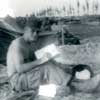
Cpl. Vernon "Randy" Randolph
(picture courtesy of Michael "Turk" Wears)
CPL.
VERNON CHESTER RANDOLPH
M Co. 3/5
Born on Apr.
22, 1943
From BETTENDORF, IOWA
Casualty was on Feb. 7, 1968
in QUANG NAM, SOUTH VIETNAM
GROUND CASUALTY
GUN, SMALL ARMS FIRE
Panel 38E - - Line 11
Memorial page
**********************
8 Feb. 1968
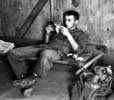
Thomas
H.C. Briggs
(Picture courtesy of Dennis Heon)
CPL.
THOMAS H.C. BRIGGS
M Co. 3/5
Born on July 8, 1947
From SANTA BARBARA, CALIFORNIA
Casualty was on Feb. 8, 1968
in THUA THIEN, SOUTH VIETNAM
Panel 38E - - Line 21
Memorial page

